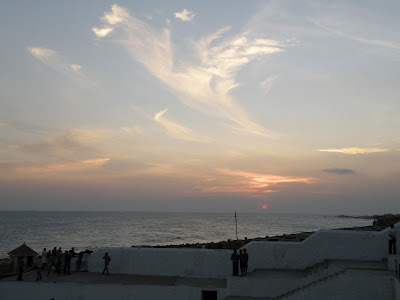This post is all about faces. Clicked randomly during my
outings in Delhi on crisp and cool winter days, these pictures tell an
interesting story about the Indian capital.
Helping her husband at their stall in Dilli Haat, this woman was as pretty as the puppets they were selling. She requested me to help her husband with English who was having a hard time bargaining with a bunch of foreigners. But he was smart. He managed to strike a deal with them without my help.
It was late evening and this paan seller outside Evergreen Sweets in Green Park Market was all bundled up, hoping to get some customers before calling it a day. I couldn't help noticing and admiring how neat and clean his stall was...picture perfect!
These two retired gentlemen found a nice sunny spot in the Aurobindo Place Market premises. They would have probably spent the entire morning there before going home for lunch.
The Deer Park has lovely walkways for strolling. And this young mother was doing exactly that with her baby.
A hawker busy arranging his wares outside the historic Jama Masjid.
A tourist taking in the sights and the sounds of the area around Jama Masjid.
This woman was enjoying her day out with her baby in the expansive courtyard of the Jama Masjid.
From the open expanses of the Jama Masjid to the congested lanes and by-lanes in Chandni Chowk. This paratha maker was busy rolling out parathas for the steady stream of visitors who were descending on his tiny eatery in the famed Gali Parathewali. Note the mound of dough by his side. Each paratha is made to order, stuffed with the filling of the customer's choice. There are dozens of options to choose from.
A group of foreigners on a guided tour of the crowded Chandni Chowk.
The rarefied atmosphere in the plush malls in Vasant Kunj is a big contrast to the hustle and bustle of Chandni Chowk. A live piano performance was adding to the classiness of the atrium in one of the malls. The place matched the opulence of the lobby of any swanky 5-star hotel.
This coffee shop looks elegant from the ground level as well as from the upper level.
People relaxing in the well-appointed lounge of the Promenade Mall, Vasant Kunj.
Another set of people in the same lounge.
It was a nice day at the Qutab Complex. These ladies and the baby were out to bask in the pleasant winter sun.
A large group of Japanese tourists arriving at the monument with a lot of excitement and anticipation.
Workers at the Qutab Complex taking a breather during their break.
Haldiram's fast food outlets are spread all over Delhi. They are known for serving spicy street food in a clean environment. Workers at an eatery in the newly opened South Square Mall in Sarojini Nagar.
Folk performers at the two-day Kite Festival organized by Delhi Tourism at the India Gate Lawns. The festival had occupied a small corner of the sprawling lawns. Professional kite fliers regaled the audience with their unusual and attractive kites.
Helping her husband at their stall in Dilli Haat, this woman was as pretty as the puppets they were selling. She requested me to help her husband with English who was having a hard time bargaining with a bunch of foreigners. But he was smart. He managed to strike a deal with them without my help.
These two retired gentlemen found a nice sunny spot in the Aurobindo Place Market premises. They would have probably spent the entire morning there before going home for lunch.
The Deer Park has lovely walkways for strolling. And this young mother was doing exactly that with her baby.
A hawker busy arranging his wares outside the historic Jama Masjid.
A tourist taking in the sights and the sounds of the area around Jama Masjid.
This woman was enjoying her day out with her baby in the expansive courtyard of the Jama Masjid.
From the open expanses of the Jama Masjid to the congested lanes and by-lanes in Chandni Chowk. This paratha maker was busy rolling out parathas for the steady stream of visitors who were descending on his tiny eatery in the famed Gali Parathewali. Note the mound of dough by his side. Each paratha is made to order, stuffed with the filling of the customer's choice. There are dozens of options to choose from.
A group of foreigners on a guided tour of the crowded Chandni Chowk.
The rarefied atmosphere in the plush malls in Vasant Kunj is a big contrast to the hustle and bustle of Chandni Chowk. A live piano performance was adding to the classiness of the atrium in one of the malls. The place matched the opulence of the lobby of any swanky 5-star hotel.
This coffee shop looks elegant from the ground level as well as from the upper level.
People relaxing in the well-appointed lounge of the Promenade Mall, Vasant Kunj.
Another set of people in the same lounge.
It was a nice day at the Qutab Complex. These ladies and the baby were out to bask in the pleasant winter sun.
A large group of Japanese tourists arriving at the monument with a lot of excitement and anticipation.
Workers at the Qutab Complex taking a breather during their break.
Haldiram's fast food outlets are spread all over Delhi. They are known for serving spicy street food in a clean environment. Workers at an eatery in the newly opened South Square Mall in Sarojini Nagar.
Folk performers at the two-day Kite Festival organized by Delhi Tourism at the India Gate Lawns. The festival had occupied a small corner of the sprawling lawns. Professional kite fliers regaled the audience with their unusual and attractive kites.































_india_500x375.jpg)

















